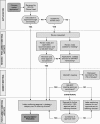Insights from early experience of a Rare Disease Genomic Medicine Multidisciplinary Team: a qualitative study
- PMID: 28327571
- PMCID: PMC5427178
- DOI: 10.1038/ejhg.2017.37
Insights from early experience of a Rare Disease Genomic Medicine Multidisciplinary Team: a qualitative study
Abstract
Whole-exome/whole-genome sequencing (WES/WGS) has the potential to enhance genetic diagnosis of rare disease, and is increasingly becoming part of routine clinical care in mainstream medicine. Effective translation will require ongoing efforts in a number of areas including: selection of appropriate patients, provision of effective consent, pre- and post-test genetic counselling, improving variant interpretation algorithms and practices, and management of secondary findings including those found incidentally and those actively sought. Allied to this is the need for an effective education programme for all members of clinical teams involved in care of patients with rare disease, as well as to maintain public confidence in the use of these technologies. We established a Genomic Medicine Multidisciplinary Team (GM-MDT) in 2014 to build on the experiences of earlier successful research-based WES/WGS studies, to address these needs and to review results including pertinent and secondary findings. Here we report on a qualitative study of decision-making in the GM-MDT combined with analysis of semi-structured interviews with GM-MDT members. Study findings show that members appreciate the clinical and scientific diversity of the GM-MDT and value it for education and oversight. To date, discussions have focussed on case selection including the extent and interpretation of clinical and family history information required to establish likely monogenic aetiology and inheritance model. Achieving a balance between effective use of WES/WGS - prioritising cases in a diverse and highly complex patient population where WES/WGS will be tractable - and meeting the recruitment targets of a large project is considered challenging.
Conflict of interest statement
The authors declare no conflict of interest.
Figures
References
-
- Biesecker LG, Green RC: Diagnostic clinical genome and exome sequencing. N Engl J Med 2014; 370: 2418–2425. - PubMed
-
- Bamshad MJ, Ng SB, Bigham AW et al: Exome sequencing as a tool for Mendelian disease gene discovery. Nat Rev Genet 2011; 12: 745–755. - PubMed
-
- Boycott KM, Vanstone MR, Bulman DE, MacKenzie AE: Rare-disease genetics in the era of next-generation sequencing: discovery to translation. Nat Rev Genet 2013; 14: 681–691. - PubMed
Publication types
MeSH terms
Grants and funding
LinkOut - more resources
Full Text Sources
Other Literature Sources
Medical




